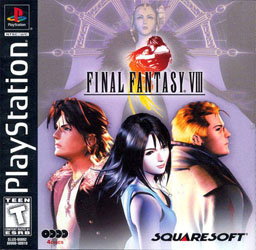Related Research Articles
Square Co., Ltd. was a Japanese video game development studio and publisher. It was founded in 1986 by Masafumi Miyamoto, who spun off part of his father's electronics company Den-Yu-Sha. Among its early employees were designers Hironobu Sakaguchi, Hiromichi Tanaka, Akitoshi Kawazu and Koichi Ishii, artist Kazuko Shibuya, programmer Nasir Gebelli, and composer Nobuo Uematsu. Initially focusing on action games, the team saw popular success with Final Fantasy in 1987. A role-playing video game, it became the first in a franchise of the same name. Later notable staff included directors Yoshinori Kitase and Takashi Tokita, designer and writer Yasumi Matsuno, artists Tetsuya Nomura and Yusuke Naora, and composers Yoko Shimomura and Masashi Hamauzu.

Xenogears is a 1998 role-playing video game developed and published by Square for the PlayStation video game console. It is the debut entry in the larger Xeno franchise. The gameplay of Xenogears revolves around navigating 3D environments both on-foot and using humanoid mecha dubbed "Gears". Combat is governed by a version of the turn-based "Active Time Battle" system. The story follows protagonist Fei Fong Wong and several others as they journey across the world to overthrow the all-powerful rule of Solaris and uncover mysteries concerning their world. The story incorporates Jungian psychology, Freudian thought, and religious symbolism.

Final Fantasy VII is a 1997 role-playing video game developed by Square for the PlayStation console and the seventh main installment in the Final Fantasy series. Square published the game in Japan, and it was released in other regions by Sony Computer Entertainment, becoming the first game in the main series to have a PAL release. The game's story follows Cloud Strife, a mercenary who joins an eco-terrorist organization to stop a world-controlling megacorporation from using the planet's life essence as an energy source. Events send Cloud and his allies in pursuit of Sephiroth, a superhuman who seeks to wound the planet and harness its healing power to be reborn as a god. During their journey, Cloud bonds with his party members, including Aerith Gainsborough, who holds the secret to saving their world.

Final Fantasy VIII is a 1999 role-playing video game developed and published by Square for the PlayStation console. It is the eighth main installment in the Final Fantasy series. Set on an unnamed fantasy world with science fiction elements, the game follows a group of young mercenaries, led by Squall Leonhart, as they are drawn into a conflict sparked by a sorceress named Edea Kramer who seized control of a powerful military state. During the quest to defeat the sorceress and the forces manipulating her, Squall struggles with his role as leader and develops a romance with one of his comrades, Rinoa Heartilly.

The Chocobo is a fictional species created for the Final Fantasy franchise by Square Enix. A galliform bird commonly having yellow feathers, they were first introduced in Final Fantasy II (1988), and have since featured in some capacity in nearly every Final Fantasy title, usually as a means of transport. Chocobos or chocobo-themed characters have played story roles in multiple titles, notably in Final Fantasy V and XIII. A recurring Chocobo also acts as protagonist of the Chocobo spin-off series.

Square Enix Holdings Co., Ltd. is a Japanese multinational holding company, video game publisher and entertainment conglomerate. It releases role-playing game franchises, such as Final Fantasy, Dragon Quest, and Kingdom Hearts, among numerous others. Outside of video game publishing and development, it is also in the business of merchandise, arcade facilities, and manga publication under its Gangan Comics brand.

In video gaming, a fan translation is an unofficial translation of a video game made by fans.

The Cactuar, known in Japan as Sabotender is a fictional species of plant-like beings from the Final Fantasy video game franchise. They are usually depicted as anthropomorphic cacti with haniwa-like faces in a running or dashing pose. One of the recurring elements of the series, it initially appeared as an enemy in Final Fantasy VI. By the 2010s, the Cactuar has attained widespread popularity with Final Fantasy fans, and is considered one of the established mascots of the long-running series alongside the Moogle and the Chocobo. While the Cactuar still appear as recurring enemies in modern titles, they are also depicted as summoned allies as well as friendly non-player characters.
Chrono Break is a cancelled third mainline entry in the Chrono series of video games by Square. While never officially announced by the company, commentary from Chrono series developers Masato Kato, Hironobu Sakaguchi, and Takashi Tokita have confirmed early plans for the game, alongside a number of trademarks filed in the game's name. However, the game would ultimately go unproduced, with many members of the internal development team either moving on to Final Fantasy XI or leaving the company in favor of freelance work. The game elicited much commentary from the company and the video game press in the following years, though as of 2021, all trademarks had expired, with no announced plans to work on the game.

Spira is the fictional world of the Square role-playing video games Final Fantasy X and X-2. Spira is the first Final Fantasy world to feature consistent, all-encompassing spiritual and mythological influences within the planet's civilizations and their inhabitants' daily lives. The world of Spira itself is very different from the mainly European-style worlds found in previous Final Fantasy games, being much more closely modeled on a setting influenced by the South Pacific, Thailand and Japan, most notably with respect to its vegetation, topography and architecture.

Alexander O. Smith is a professional Japanese to English translator and author. While his output covers many areas such as adaptation of Japanese novels, manga, song lyrics, anime scripts, and various academic works, he is best known for his software localizations of Japanese video games including Vagrant Story, Phoenix Wright: Ace Attorney, and Final Fantasy XII. He currently resides in Kamakura, Japan, where he operates his own contract localization business, Kajiya Productions, and is co-founder of a translation and publishing company, Bento Books.

Ted Woolsey is an American video game translator and producer. He had the primary role in the North American production and localization of Square's role-playing video games released for the Super NES between 1991 and 1996. He is best known for translating Final Fantasy VI and Chrono Trigger during his time at Square. Limitations on text length and strict content guidelines forced Woolsey to make many script changes in his translation work, which became known as "Woolseyisms" in popular culture and were both praised and criticized.

Final Fantasy Fables: Chocobo's Dungeon is a 2007 role-playing video game published by Square Enix for the Wii. It is an installment in the Chocobo series that focuses on Chocobo and his quest to free a town lost in time from eternal forgetfulness. It is a loose sequel to Chocobo's Dungeon 2 on the PlayStation.
The Chocobo video game series is a spin-off series composed of over a dozen games developed by Square Co. and later by Square Enix featuring a super deformed version of the Chocobo, a Final Fantasy series mascot and fictional bird, as the protagonist. Several of the titles have received separate album releases of music from the game. The music of the Chocobo series includes soundtrack albums for the Chocobo's Mysterious Dungeon sub-series—comprising Chocobo's Mysterious Dungeon, Chocobo's Dungeon 2, and Final Fantasy Fables: Chocobo's Dungeon—and soundtrack albums of music from Chocobo Racing, Final Fantasy Fables: Chocobo Tales, and Chocobo and the Magic Picture Book: The Witch, The Maiden, and the Five Heroes, as well as an album of arranged music from Chocobo's Mysterious Dungeon and a single entitled Chocobo no Fushigina Dungeon Toki Wasure No Meikyuu: Door Crawl for the theme song of Final Fantasy Fables: Chocobo's Dungeon.
The Japanese video game developer and publisher Square Enix has been translating its games for North America since the late 1980s, and the PAL region and Asia since the late 1990s. It has not always released all of its games in all major regions, and continues to selectively release games even today depending on multiple factors such as the viability of platforms or the condition of the game itself. The process of localization has changed during that time from having a one-person team with a short time and tight memory capacities to having a team of translators preparing simultaneous launches in multiple languages.

Final Fantasy Type-0 HD is an action role-playing game developed by Square Enix and HexaDrive, and published by Square Enix for PlayStation 4 and Xbox One, and later for Windows via Steam. It was released worldwide in March 2015, while the Steam port was released in August. Type-0 HD is a high-definition remaster of the Japan-exclusive PlayStation Portable game Final Fantasy Type-0, a spin-off from the main Final Fantasy series and part of the Fabula Nova Crystallis subseries, a set of games sharing a common mythos. The story focuses on Class Zero, a group of fourteen students from the Dominion of Rubrum who must fight the neighboring Militesi Empire when they launch an assault on the other Crystal States of Orience. In doing so, the group become entangled in both the efforts to push back and defeat the forces of Militesi, and the secret behind the war and the existence of the crystals.

Final Fantasy XV, an action role-playing video game released in November 2016, is the fifteenth main installment in the Final Fantasy series, and is thematically connected to Fabula Nova Crystallis Final Fantasy, a subseries of games linked by a common mythos which includes Final Fantasy XIII and Final Fantasy Type-0. The world and main characters were created by Tetsuya Nomura, the game's original director. Nomura also designed the main characters, with later revisions and additional characters being designed by Yusuke Naora: other character designers involved with the game included Roberto Ferrari and Yusaku Nakaaki.
Prompto Argentum is a character from Square Enix's Final Fantasy series. He first appears in the anime web series Brotherhood: Final Fantasy XV as a schoolmate of the crown prince of the Kingdom of Lucis, Noctis Lucis Caelum. In the 2016 mainline title Final Fantasy XV, Prompto accompanies Noctis on his journey by road to meet and marry a noblewoman from another nation, and fights alongside him as they oppose the Niflheim empire. He is the title character of the post-launch downloadable content (DLC) pack Episode Prompto, which delves into the character's backstory and origin as a pawn of Niflheim.
References
- 1 2 3 Orner, Daniel. "Interview with Richard Honeywood about Final Fantasy XI". Final Fantasy Compendium. Archived from the original on 13 February 2009. Retrieved 13 January 2016.
- 1 2 Orner, Daniel. "Interview with Richard Honeywood". Final Fantasy Compendium. Archived from the original on 28 February 2016. Retrieved 13 January 2016.
- 1 2 3 4 5 "8-4 Play 4/22/2011: PROJECT CAFÉ OLÉ « 8-4". 8-4. 23 April 2011. Archived from the original on 20 July 2011. Retrieved 18 July 2011.
- 1 2 3 4 5 6 7 8 Fenlon, Wesley (28 April 2011). "The Rise of Squaresoft Localization". 1UP.com. Archived from the original on 2015-06-10. Retrieved 8 October 2013.
- 1 2 Parish, Jeremy (11 March 2007). "GDC 2007: The Square-Enix Approach to Localization". 1UP.com. Archived from the original on 15 October 2012. Retrieved 28 March 2013.
- ↑ Cidolfas (30 May 2004). "Interview with Richard Honeywood". FFCompendium. Archived from the original on 2 June 2015. Retrieved 6 September 2008.
- 1 2 3 4 5 6 7 8 9 10 11 12 13 14 15 "Q&A – Square Enix's Richard Honeywood". Edge Online. February 2006. Archived from the original on 17 May 2006. Retrieved 28 March 2013.
- ↑ Jeriaska (27 April 2007). "Localization Tactics: A Conversation with Alexander O. Smith". Square Haven. Archived from the original on 7 March 2013. Retrieved 28 March 2013.
- ↑ Birlew, Dan (2001). Final Fantasy X Official Strategy Guide. BradyGames. p. 268. ISBN 0-7440-0140-4.
- ↑ Honeywood, Richard (2016). "Richard Honeywood LinkedIn profile". LinkedIn. Retrieved 3 January 2016.
- 1 2 "Spirited Away Animators Breathe Life Into Astonishing New Game". WIRED . 22 January 2013. Archived from the original on 7 January 2016. Retrieved 28 December 2015.
- ↑ "Ni no Kuni: the language of magic". Wired UK . Archived from the original on 22 January 2016. Retrieved 28 December 2015.
- ↑ Kohler, Chris (July 21, 2017). "5 Hours With The New Layton: Great Writing, Weak Puzzles". Kotaku. Retrieved July 5, 2020.
- ↑ Schreier, Jason (March 23, 2018). "Ni no Kuni II: The Kotaku Review". Kotaku. Retrieved July 5, 2020.
- ↑ Musgrave, Shaun (February 24, 2020). "SwitchArcade Round-Up: Reviews of 'Snack World', 'Darksiders Genesis', and 'SEGA AGES Sonic 2', Today's New Releases and the Latest Sales". Touch Arcade. Retrieved July 5, 2020.